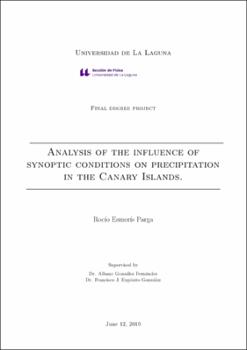Analysis of the influence of synoptic conditions on precipitation in the Canary Islands.
Author
Esmorís Parga, RocíoDate
2019Abstract
The present work analyzes the atmospheric synoptic conditions which mainly affect
rain episodes over the Canary Islands. The main aims are to assess the reliability of
two databases used to determine the weather in the Canary Islands and to study the
phenomenological distribution of rain episodes.
To achieve these aims is especially important to keep into account 3 specific features
of the Canary Islands. First, their particular location: close to the African continent
in a transition area from mild to tropical temperatures affected by the North Atlantic
Oscillation (NAO) and the Azores High. Second, the common weather conditions: the
archipelago is considered as a dry and very stable area, having over 50 raining episodes
per year on average. Third, its steep orography: altitude varies more than 3000m in less
than 20km horizontally.
After setting these features, a phenomenological classification is given. A total of 4
atmospheric disturbance phenomena are classified: Deep Atlantic Lows (DAL), Atlantic
Surface Lows (ASL), upper Atlantic Lows (UAL) and Troughs (TRO) are the considered
phenomena used to characterize the Canary Islands weather. The phenomena which are
not possible to include in any of these categories are included in No detection type (ND,
None).
Using some online resources, such as the AEMET database ARCIM´IS, and Meteo
Centre Reanalysis, a set of 104 cases of heavy rain (>30mm episodes) is analyzed to
better understand the particular situations in the atmosphere. Furthermore, this type
of analysis gives a reliable method to compare the further automatic classification of the
phenomena.
After that, the AEMET database is analyzed. This particular database shows the
distribution of heavy rain (> 30mm) and all the rain (> 1mm) in the Canary Islands.
These data are further used to compare the reliability of the numerical databases.
Then, Spread and WRF databases are analyzed. Maps of the distribution of the above
classification is shown for these two databases. First, 10 and 1mm maps, then, seasonal
maps. In this way, both databases are easily compared and furthermore, it is possible
to set which are the main phenomena affecting the Canary Islands and their particular
location.
Finally, as conclusions: the correspondence between these databases is exposed as well
the most important phenomena over the Canary Islands. The correspondence between
databases is particularly trustworthy. The most important phenomenon affecting the
Canary Islands is DAL and it is prominent during the winter. En la presente memoria se pretende analizar las perturbaciones atmosf´ericas que dan
lugar a las precipitaciones m´as importantes en las Islas Canarias. Los objetivos principales
del trabajo son establecer la fiabilidad de las bases de datos para determinar los fen´omenos
de precipitaciones as´ı como estudiar la distribuci´on de los episodios de lluvia.
Para lograr estos objetivos es particularmente importante tener en cuenta tres caracter´ısticas de las Islas Canarias. Primero, su localizaci´on peculiar: cercanas al continente
africano en una zona de transici´on de temperaturas suaves a tropicales, afectadas por la
Oscilaci´on del Atl´antico Norte (NAO) y por el anticicl´on de las Azores. En segundo lugar, las condiciones clim´aticas generales: el Archipi´elago Canario est´a considerado como
un ´area seca y estable, con una media de 50 episodios de lluvia al a˜no. En tercer lugar, su abrupta orograf´ıa: se alcanzan alturas de m´as de 3000 m en menos de 20 km
horizontalmente.
Una vez se han establecido las caracter´ısticas anteriores, se proporciona una clasificaci´on fenomenol´ogica. Dicha clasificaci´on contiene 4 casos de perturbaciones atmosf´ericas:
bajas atl´anticas profundas (DAL), bajas atl´anticas en superficie (ASL), bajas atl´anticas
en altura (UAL) y vaguadas (TRO). Con estos fen´omenos se pretende caracterizar esta
situaci´on especial de precipitaciones en las Islas Canarias. Los episodios que no ha sido
posible incluir en ninguno de los anteriores fen´omenos se han incluido en la catergor´ıa de
ninguna detecci´on (ND, None).
Usando recursos en l´ınea tales como la base de datos ARCIM´IS de AEMET y Meteo
Centre Reanalysis, se analizan, con el fin de entender completamente las situaciones particulares de la atm´osfera para esos fen´omenos, un conjunto de 104 casos de lluvias extremas
(episodios de m´as de 30 mm en alg´un punto). Adem´as, este tipo de an´alisis proporciona
un m´etodo fiable para comparar la clasificaci´on autom´atica de los fen´omenos.
Despu´es, se analiza la base de datos de AEMET. Usando esta base se estudian las
distribuciones de lluvia extrema (> 30mm) y de la lluvia total (> 1mm). M´as tarde estos
datos se usan para comparar la fiabilidad de las otras dos bases de datos.
Luego, se analizan las bases de datos Spread y WRF. Se muestran mapas de estas dos
bases de datos donde se indican la distribuci´on de los fen´omenos clasificados. Primero se
analizan mapas de 10 y 1 mm y despu´es mapas por estaciones. De esta forma, se pueden
comparar de forma clara ambas bases de datos y adem´as es posible establecer cu´ales son
los fen´omenos que afectan principalmente a las Islas Canarias y d´onde est´an localizados.
Finalmente, a modo de conclusiones se establece que: primero, la correspondencia
entre las bases de datos es fidedigna. Segundo, el fen´omeno m´as importante durante los
episodios de lluvia es DAL y la estaci´on que deja m´as lluvias es el invierno.





